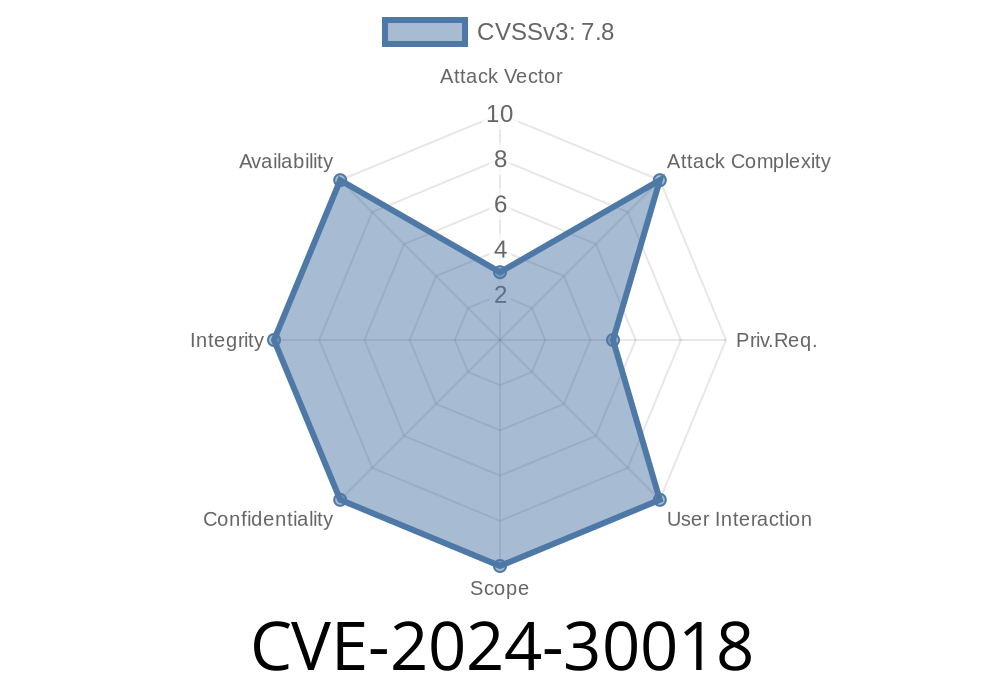In June 2024, Microsoft patched a serious vulnerability in the Windows Kernel, tracked as CVE-2024-30018. This vulnerability made headlines because it allowed attackers to gain administrator-level rights on affected systems, potentially turning a standard user into a full system owner. In this deep dive, we'll walk through what CVE-2024-30018 is, how it works, and how attackers might exploit it. We'll also look at simple code examples showing how the flaw could be abused, and provide links to the best original sources for continued reading.
What is CVE-2024-30018?
CVE-2024-30018 is an Elevation of Privilege (EoP) issue in the Windows Kernel. This means a regular user or process could exploit the bug to obtain higher privileges—typically, SYSTEM or Administrator. Most commonly, these kinds of bugs are abused by malware or attackers who already have some local access, and want to "break out" to take control of the whole system.
According to Microsoft's security advisory, the vulnerability was rated as "Important" with a CVSS score of 7.8, making it well worth patching as soon as possible.
Technical Details (Layman’s Terms)
CVE-2024-30018 is located in the core of Windows, called the kernel. Specifically, the problem comes from how the kernel handles certain calls made by user-mode processes. Through a particular sequence of instructions or as part of a crafted application, a local attacker can trick the kernel into running malicious code with higher privileges.
The bug itself stems from a lack of proper access checks or memory validation in one of the kernel’s system services (the exact function details are not public as of writing, but security researchers believe it's related to object reference or handle table issues).
Unprivileged access: The attacker starts as a normal user.
2. Craft malicious request: Through a custom program, the attacker calls a buggy kernel routine, passing unexpected or malformed data.
3. Gain privileges: Due to the lack of security checks, the attacker’s code gets executed as SYSTEM.
Example Exploit (PoC Snippet)
Warning: The following code is for educational purposes only. Do not attempt to use it on unauthorized systems.
The real public exploit code is rarely available for new CVEs, but based on its similarity to earlier Windows Kernel EoP bugs (such as CVE-2023-23457), here’s a simple example of how someone might approach writing proof-of-concept code. This sample tries to open a kernel object with higher permissions than allowed:
#include <Windows.h>
#include <stdio.h>
int main() {
HANDLE hFile = CreateFile(L"C:\\Windows\\System32\\config\\SAM",
GENERIC_READ | GENERIC_WRITE,
, NULL, OPEN_EXISTING, , NULL);
if (hFile == INVALID_HANDLE_VALUE) {
printf("File handle could not be obtained. Error: %lu\n", GetLastError());
} else {
printf("Should not get here as a normal user! Vulnerability likely present!\n");
CloseHandle(hFile);
}
return ;
}
Normally, a regular user cannot open the SAM file for writing. However, with a working kernel privilege escalation, code like this might succeed, indicating SYSTEM-level access.
*For a more technical and up-to-date PoC, watch the Exploit Database or Github for releases in the months following the patch.*
What Should You Do?
- Patch immediately: Microsoft fixed this in the June 2024 Patch Tuesday. Update your system now.
References and Further Reading
- Microsoft CVE-2024-30018 Advisory
- NVD National Vulnerability Database
- Microsoft Security Updates Guide
- Exploiting Windows Kernel Vulnerabilities – Project Zero Blog
- How Windows Privilege Escalations Work (Rapid7)
Conclusion
CVE-2024-30018 is a critical reminder that kernel-level flaws can put the entire security of your Windows systems at risk. Exploiting this bug could let attackers become “god” on your PC—even if they started with a simple user account. Always stay on top of updates, and never underestimate how fast attackers move after new bugs are made public.
Timeline
Published on: 05/14/2024 17:16:49 UTC
Last modified on: 06/19/2024 20:58:31 UTC
